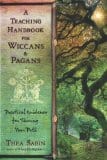 A Teaching Handbook for Wiccans and Pagans, by Thea Sabin
A Teaching Handbook for Wiccans and Pagans, by Thea Sabin
Llewellyn Worldwide, 978-0-7387-2710-3, 309 pp., 2012
It has been a number of years since I have read any of Thea’s writings. In fact, it had been so long that, when I saw a quote from my review of her previous work, I had to go back and reread that review. As I delved into this latest work, my original opinion seems to have been more than borne out. I was impressed by her practicality at the time, and I am even more impressed by it at this time. If there is one thing sadly lacking in the field of Pagan education (after discounting the lack of uniformity) it is common sense. Thea supplies that in abundance.
This is a collaborative effort. Ms Sabin approached numerous teachers of Pagan topics – those who teach in-person; those who teach online; those who have been teaching for years; and those who are just starting out as teachers – on a variety of approaches, techniques and pitfalls. You know those things which are “needless to say…”, she says them because since everyone knows them, we often forget to include them in our thinking and preparations. You know the kind of disaster I mean – you have all your media on a flash drive, but when you arrive at the location you discover that the files have been corrupted (or even worse, you grabbed the wrong flash drive)…how do you recover? Or you have that one student who seems bound and determined to wrest control of the class away from you…how do you deal with the situation?
One thing you have to give Ms Sabin is that she is thorough. She doesn’t overwhelm the reader, but she also doesn’t over-simplify things. She explores topics in depth and from a variety of angles. She includes personal anecdotes (both hers and others) to help the reader understand the point. She makes her point, and then reinforces it just enough to make sure it stays with the reader.
Throughout this book you get the feeling that she has been there and encountered that, regardless what “this” and “that” mean in any particular instance. She explains the benefits and pitfalls which await on the path of teaching. Then, just to make it all seem a little easier, she provides (in the appendices) a large selection of screening questions as a source of guidance for helping you avoid those students who just won’t be a good fit for your group or style of teaching and a couple of sample syllabuses showing how to plan your classes. Naturally, she provides a listing of resources to help your own growth as a teacher – in a variety of formats from print to video classes and blogs. It is all wrapped up by a short bio of each of those individuals who contributed their own points of view and suggestions.
If you plan to teach classes on Paganism and/or Wicca, run a group, or work on interfaith groups – this is a book which will serve you well.








